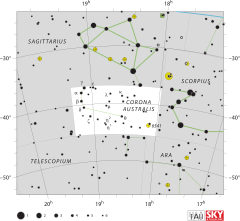Alpha Coronae Australis
| Observation data Epoch J2000.0 Equinox J2000.0 (ICRS) | |
|---|---|
| Constellation | Corona Australis |
| Right ascension | 19h 09m 28.34097s[1] |
| Declination | –37° 54′ 16.1022″[1] |
| Apparent magnitude (V) | 4.102[2] |
| Characteristics | |
| Spectral type | A2V[3] |
| U−B color index | +0.06[4] |
| B−V color index | +0.04[4] |
| Astrometry | |
| Radial velocity (Rv) | −18.40±1.78[5] km/s |
| Proper motion (μ) | RA: 84.87[1] mas/yr Dec.: −95.99[1] mas/yr |
| Parallax (π) | 26.02 ± 0.25 mas[1] |
| Distance | 125 ± 1 ly (38.4 ± 0.4 pc) |
| Absolute magnitude (MV) | 1.11[6] |
| Details | |
| Mass | 2.57[7] M☉ |
| Radius | 2.21[3] R☉ |
| Luminosity | 31[8] L☉ |
| Surface gravity (log g) | 4.08[7] cgs |
| Temperature | 9,916±337[7] K |
| Rotational velocity (v sin i) | 195[9] km/s |
| Age | 254[2] Myr |
| Other designations | |
| Database references | |
| SIMBAD | data |
Alpha Coronae Australis or α Coronae Australis, officially named Meridiana (/məˌrɪdiˈænə/),[10] is the brightest star in the constellation of Corona Australis and is located about 125 light-years from Earth.
Nomenclature
α Coronae Australis (Latinised to Alpha Coronae Australis) is the star's Bayer designation.
It is the only star in the constellation with a traditional proper name, Alphekka Meridiana (Latin for 'Alphekka South'), after Alphecca, the brightest star in the constellation Corona Borealis.[citation needed] The name Alphecca or Alphekka is Arabic, short for نير الفكّة nayyir al-fakka "the bright (star) of the broken (ring of stars)".[11] In 2016, the IAU organized a Working Group on Star Names (WGSN)[12] to catalog and standardize proper names for stars. The WGSN approved the name Meridiana for this star on 5 September 2017 and it is now so included in the List of IAU-approved Star Names.[10]
In Chinese, 鱉 (Biē), meaning River Turtle, refers to an asterism consisting of Alpha Coronae Australis, Alpha Telescopii, Eta¹ Coronae Australis, Zeta Coronae Australis, Delta Coronae Australis, Beta Coronae Australis, Gamma Coronae Australis, Epsilon Coronae Australis, HD 175362, Kappa² Coronae Australis and Theta Coronae Australis.[13] Consequently, the Chinese name for Alpha Coronae Australis itself is 鱉六 (Biēliù, English: the Sixth Star of River Turtle.).[14]
Properties
Alpha Coronae Australis belongs to the spectral class A2Va, making it an A-type star like Vega. Like the latter, it has excess infrared radiation, which indicates it may be ringed by a disk of dust.[8] It has an apparent magnitude of +4.10.[4] The star's mass and radius are estimated at 2.3 times the Sun's mass and radius. With an effective temperature of roughly 9,100 K, the star radiates a total luminosity of about 31 times the Sun's.[8] This star is roughly 254 million years old.[2] A rapidly rotating star, it spins at almost 200 km per second at the equator, making a complete revolution in approximately 14 hours,[9] close to its breakup velocity.
See also
- Lists of stars in the constellation Corona Australis
- Class A Stars
- Vega
- Circumstellar disk
References
- ^ a b c d e van Leeuwen, F. (November 2007). "Validation of the new Hipparcos reduction". Astronomy and Astrophysics. 474 (2): 653–664. arXiv:0708.1752. Bibcode:2007A&A...474..653V. doi:10.1051/0004-6361:20078357. S2CID 18759600.
- ^ a b c Song, Inseok; et al. (February 2001), "Ages of A-Type Vega-like Stars from uvbyβ Photometry", The Astrophysical Journal, 546 (1): 352–357, arXiv:astro-ph/0010102, Bibcode:2001ApJ...546..352S, doi:10.1086/318269, S2CID 18154947
- ^ a b Cotten, Tara H.; Song, Inseok (July 2016). "A Comprehensive Census of Nearby Infrared Excess Stars". The Astrophysical Journal Supplement Series. 225 (1): 24. arXiv:1606.01134. Bibcode:2016ApJS..225...15C. doi:10.3847/0067-0049/225/1/15. S2CID 118438871. 15.
- ^ a b c d "* alf CrA". SIMBAD. Centre de données astronomiques de Strasbourg. Retrieved 2012-09-02.
- ^ Kharchenko, N. V.; et al. (2007). "Astrophysical supplements to the ASCC-2.5: Ia. Radial velocities of ~55000 stars and mean radial velocities of 516 Galactic open clusters and associations". Astronomische Nachrichten. 328 (9): 889. arXiv:0705.0878. Bibcode:2007AN....328..889K. doi:10.1002/asna.200710776. S2CID 119323941.
- ^ "α Coronae Australis (star)". Wolfram Alpha. Retrieved 2012-09-02.
- ^ a b c David, Trevor J.; Hillenbrand, Lynne A. (2015). "The Ages of Early-Type Stars: Strömgren Photometric Methods Calibrated, Validated, Tested, and Applied to Hosts and Prospective Hosts of Directly Imaged Exoplanets". The Astrophysical Journal. 804 (2): 146. arXiv:1501.03154. Bibcode:2015ApJ...804..146D. doi:10.1088/0004-637X/804/2/146. S2CID 33401607.
- ^ a b c Kaler, James B. "ALFECCA MERIDIANA (Alpha Coronae Australis)". Stars. University of Illinois. Retrieved 2012-09-02.
- ^ a b Royer, F.; Zorec, J.; Gómez, A. E. (February 2007). "Rotational velocities of A-type stars. III. Velocity distributions". Astronomy and Astrophysics. 463 (2): 671–682. arXiv:astro-ph/0610785. Bibcode:2007A&A...463..671R. doi:10.1051/0004-6361:20065224. S2CID 18475298.
- ^ a b "Naming Stars". IAU.org. Retrieved 16 December 2017.
- ^ Allen, Richard Hinckley (1963) [1899]. Star Names: Their Lore and Meaning (Reprint ed.). New York, NY: Dover Publications Inc. pp. 172–73. ISBN 0-486-21079-0.
- ^ "IAU Working Group on Star Names (WGSN)". Retrieved 22 May 2016.
- ^ (in Chinese) 中國星座神話, written by 陳久金. Published by 台灣書房出版有限公司, 2005, ISBN 978-986-7332-25-7.
- ^ (in Chinese) 香港太空館 - 研究資源 - 亮星中英對照表 Archived 2008-10-25 at the Wayback Machine, Hong Kong Space Museum. Accessed on line November 23, 2010.
- Articles with Chinese-language sources (zh)
- Webarchive template wayback links
- Articles with short description
- Short description with empty Wikidata description
- All articles with unsourced statements
- Articles with unsourced statements from August 2022
- Articles containing Chinese-language text
- Articles containing explicitly cited English-language text
- A-type main-sequence stars
- Corona Australis
- Bayer objects
- Durchmusterung objects
- Henry Draper Catalogue objects
- Hipparcos objects
- Bright Star Catalogue objects
- Stars with proper names
